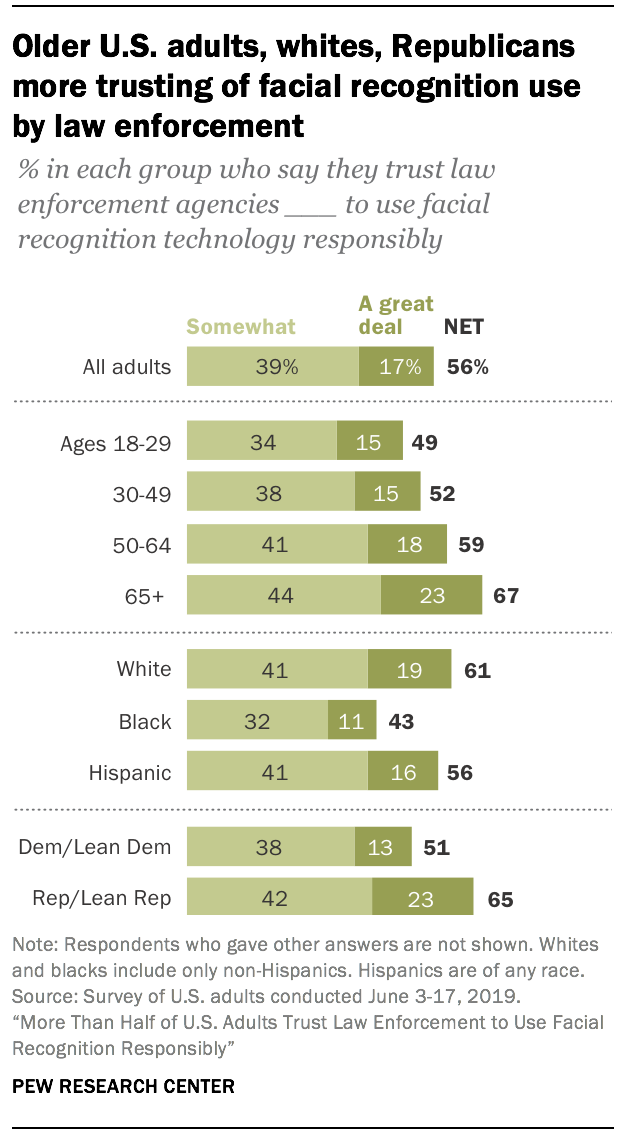More Than Half of U.S. Adults Trust Law Enforcement to Use Facial Recognition Responsibly

A new Pew Research Center survey finds that a majority of Americans trust law enforcement agencies to use these technologies responsibly. A similar share of the public (59%) says it is acceptable for law enforcement to use facial recognition tools to assess security threats in public spaces.
At the same time, the survey finds that the relatively broad acceptance of facial recognition use by law enforcement does not necessarily apply to other entities that might use the technologies. Smaller shares of the public say they trust technology companies (36%) or advertisers (18%) to use facial recognition responsibly. And minorities of the public would find it acceptable for these tools to be used for purposes such as tracking who is entering or leaving apartment buildings (36%), monitoring the attendance of employees at a place of business (30%) or seeing how people respond to public advertising displays in real time (15%).
The attitudes also differ across demographic groups. For instance, a substantially smaller share of young adults think it is acceptable for law enforcement to use facial recognition to assess security threats in public spaces relative to older Americans.
The American public has a broad awareness of automated facial recognition technologies that can identify someone based on a picture or video that includes their face. Most Americans – 86% in total – have heard at least something about facial recognition technology, with 25% saying they have heard a lot about these systems. Just 13% of the public has not heard anything about facial recognition.
Awareness of the systems is relatively widespread across a range of demographic groups, though there is modest variation in awareness based on factors such as educational attainment. The research shows that 95% of Americans with a college degree or higher have heard at least something about facial recognition technology, with 28% of college graduates saying they have heard a lot about it. But overall awareness falls to 79% (with 19% saying they have heard a lot) among those with a high school diploma or less. Awareness is also slightly higher among those with higher household incomes compared with those with lower incomes; among men relative to women; and among whites relative to blacks and Hispanics.
Majority of Americans trust law enforcement to use facial recognition responsibly; people are less trusting of advertisers, tech companies
When asked about their confidence that different entities will use facial recognition tools responsibly, the public expresses much greater trust in law enforcement agencies than in advertisers or technology companies. A 56% majority of U.S. adults trust law enforcement agencies at least somewhat to use facial recognition technologies responsibly, with 17% indicating that they trust the agencies a great deal to use facial recognition.
Around one-third of U.S. adults trust technology companies to use facial recognition technology responsibly, and just 18% trust advertisers with the technologies, the research says. Only 5% of Americans have a great deal of trust that technology companies will use facial recognition responsibly, and just 2% have high levels of trust in its use by advertisers.
Americans more accepting of facial recognition use by law enforcement to assess public security threats than of use in other situations
When asked a separate set of questions about whether the use of facial recognition technology is acceptable under certain circumstances, the research says that the public expresses more acceptance of these tools when used by law enforcement agencies than in other situations. A 59% majority of U.S. adults think it is acceptable for law enforcement agencies to use facial recognition technology to assess potential security threats in public spaces, while just 15% find this unacceptable. The rest are either unsure if this is acceptable or have not heard of facial recognition technology in the first place.
By comparison, larger shares of Americans find it unacceptable than find it acceptable for companies to use these technologies to automatically track the attendance of their employees (30% acceptable, 41% not acceptable), or for advertisers to use these tools to see how people respond to public advertising displays (15% acceptable, 54% unacceptable). According to the research, the public is largely split on apartment building landlords using this technology to track who is entering or leaving their buildings: 36% think this is an acceptable use of facial recognition technology, but 34% think it is not.
Despite some well-publicized examples in which facial recognition technologies have misidentified individual people or struggled to recognize certain types of faces, most Americans consider these tools to be relatively effective. Roughly three-quarters of U.S. adults (73%) think facial recognition technologies are at least somewhat effective at accurately identifying individual people. Smaller majorities think these tools are effective at accurately assessing someone’s gender (63%) or race (61%).
According to the research, larger shares of men than women think facial recognition tools are effective in each of these circumstances, and whites are consistently more likely to view them as effective than are blacks or Hispanics. Additionally, those who have heard more about facial recognition tend to have more positive opinions of its effectiveness in each of the areas.
Looking for a reprint of this article?
From high-res PDFs to custom plaques, order your copy today!











